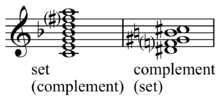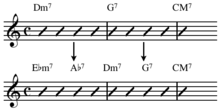Outside (jazz)
Appearance



In jazz, side-slipping, sidestepping, or outside playing, is a technique in which, during improvisation, one plays only the five "'wrong'" non-scale notes for the given chord and none of the seven scale or three to four chord tones, given that there are twelve notes in the equal tempered scale and heptatonic scales are generally used.[1]
In the example on the rhythm changes B section to the right, the (heptatonic) scale for each chord would be:
E7 - E mixolydian A7 - A mixolydian D7 - D mixolydian G7 - G mixolydian C - C major
Thus the non-scale notes would be those of the following (pentatonic) scales:
E7 - E♭ major pentatonic A7 - A♭ major pentatonic D7 - D♭ major pentatonic G7 - G♭ major pentatonic C - G♭ major pentatonic
One technique used for sideslipping is the addition of distant ii-V relationships, such as a half-step above the original ii-V. This increases chromatic tension as it first moves away and then towards the tonic.[2]
